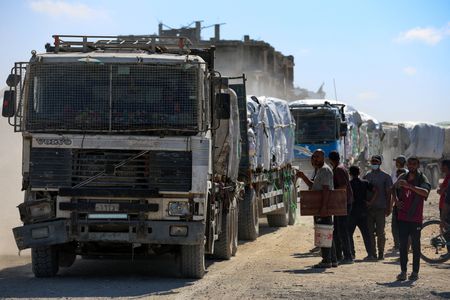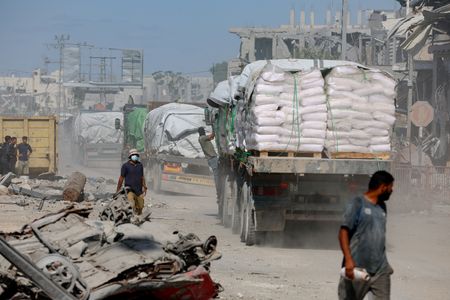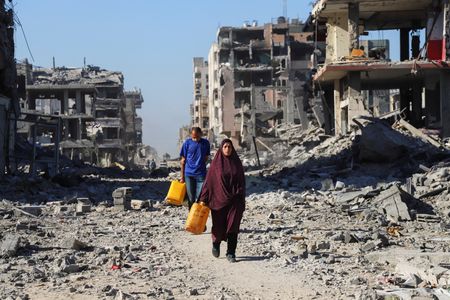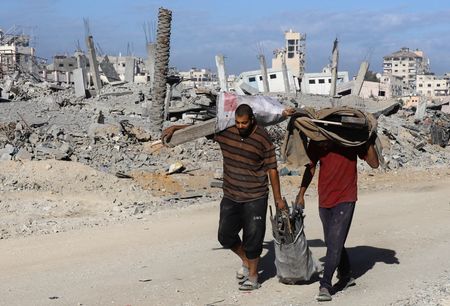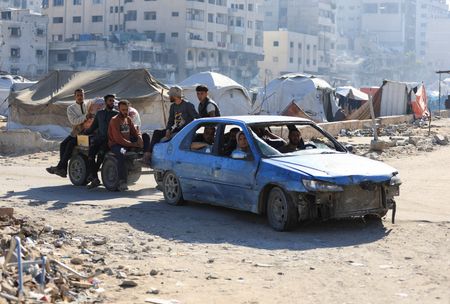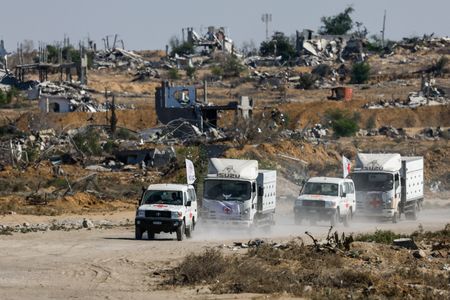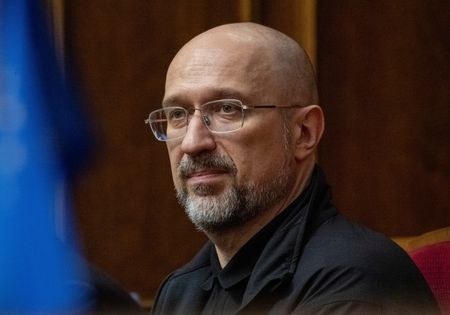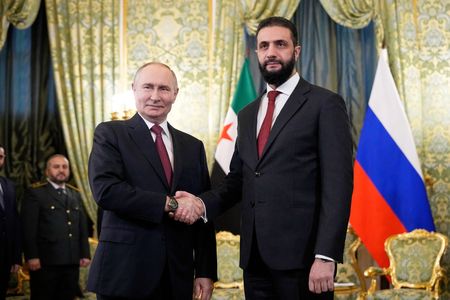By Steven Scheer and Nidal al-Mughrabi
JERUSALEM/CAIRO (Reuters) -Aid trucks rolled into Gaza on Wednesday and Israel resumed preparations to open the main Rafah crossing after a dispute over the return of the bodies of dead hostages that had threatened to derail the fragile ceasefire deal with Hamas.
Israel had threatened to keep Rafah shut and reduce aid supplies because Hamas was returning bodies too slowly, showing the risks to a truce that has stopped two years of devastating warfare in Gaza and freed all living hostages held by Hamas.
However, the militant group returned more Israeli bodies overnight, and an Israeli security official said on Wednesday preparations were under way to open Rafah to Gazan citizens, while a second official said that 600 aid trucks would go in.
DISPUTE OVER RETURN OF HOSTAGE BODIES
Hamas returned four bodies confirmed as dead hostages on Monday and another four bodies late on Tuesday, though Israeli authorities said one of those bodies was not that of a hostage.
The dispute over the return of bodies still has the potential to upset the ceasefire deal along with other major issues that are yet to be resolved.
Later phases of the truce call for Hamas to disarm and cede power, which it has so far refused to do. It has launched a security crackdown, parading its power in Gaza through public executions and clashes with local clans.
Longer-term elements of the ceasefire plan, including how Gaza will be governed, the make-up of an international force to take over there and moves towards the creation of a Palestinian state have yet to emerge.
Twenty-one bodies of hostages remain in Gaza, though some may be hard to find or recover because of destruction during the conflict. An international task force is meant to find them.
The deal also requires Israel to return the bodies of 360 Palestinians. The first group of 45 was handed over on Tuesday and the bodies were being identified, said Palestinian health authorities.
AID ENTRY AND BORDER CROSSING
The war has caused a humanitarian catastrophe in Gaza, with nearly all inhabitants driven from their homes, a global hunger monitor saying famine was present in the enclave and health authorities overwhelmed.
“Our situation is utterly tragic. We went back to our homes in the al-Tuffah neighbourhood and found there are no homes at all. There is no shelter. Nothing,” said Moemen Hassanein in Gaza City, with tents and shanties behind him.
Reuters video showed a first group of trucks moving from the Egyptian side of the border into the Rafah crossing at dawn on Wednesday, some tankers carrying fuel and others loaded with pallets of aid.
However, it was not clear if that convoy would complete its crossing into Gaza as part of the 600 trucks that were due to enter the enclave on Wednesday – the full daily complement required under the ceasefire plan. Aid trucks entered Gaza through other crossings.
“Humanitarian aid continues to enter the Gaza Strip through the Kerem Shalom Crossing and other crossings after Israeli security inspection,” the Israeli security official said.
Israel’s public broadcaster Kan reported that Wednesday’s aid deliveries would include food, medical supplies, fuel, cooking gas and equipment to repair vital infrastructure.
Underscoring the political challenges facing the truce, Israel’s far-right National Security Minister Itamar Ben-Gvir, an opponent of the ceasefire plan, said on X that the aid delivery was a “disgrace”.
“Nazi terrorism understands only force, and the only way to solve problems with it is to wipe it off the face of the earth,” he added, accusing Hamas of lies and abuse over the return of hostages’ bodies.
Rafah is due to be opened to Palestinian inhabitants of Gaza either entering or exiting the enclave. But those awaiting medical evacuation told Reuters they had not yet received notification to prepare for travel.
The Palestinian Authority, which governs in the Israeli-occupied West Bank, is preparing to operate the Rafah crossing into Egypt, which it previously did with EU assistance. Israel closed the crossing in 2007 after Hamas took over the enclave, but later allowed some movement through it under an agreement with Egypt.
VIOLENCE IN GAZA
Several other Palestinian factions present in Gaza have backed the days-long Hamas security crackdown as it battles local clans that had tried to take over areas of the territory during the conflict.
The Popular Front for the Liberation of Palestine, one of the groups backing the Hamas crackdown, described the clans being targeted as “hubs of crime”.
The ceasefire envisaged Hamas initially restoring order in Gaza and U.S. President Donald Trump, who brokered the deal, endorsed Hamas’ crackdown on rival gangs, while warning it would face airstrikes if it did not later disarm.
Palestinian Authority chairman Mahmoud Abbas condemned the public executions after a video, authenticated by Reuters, showed masked gunmen shooting dead seven bound, kneeling men in a Gaza street.
Israeli forces inside Gaza have pulled back to what the truce deal calls a yellow line just outside the main cities. Israeli Defence Minister Israel Katz said it would immediately enforce any violation of the line.
(Reporting by Steven Scheer and Maayan Lubell in Jerusalem, Nidal al-Mughrabi in Cairo and Olivia Le Poidevin in Geneva; additional reporting by Tala Ramadan, Jana Choukeir and Ahmed Elimam in Dubai; Writing by Angus McDowall; Editing by Ros Russell)

